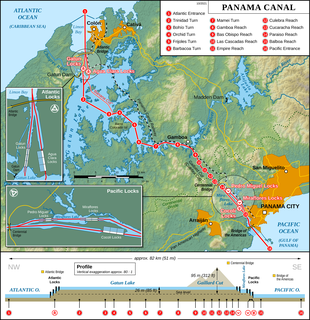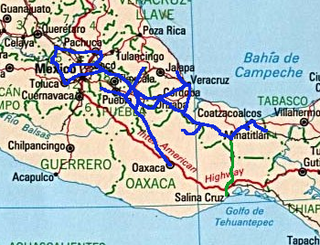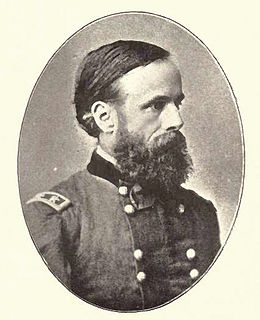Related Research Articles

The Nicaraguan Canal, formally the Nicaraguan Canal and Development Project was a proposed shipping route through Nicaragua to connect the Caribbean Sea with the Pacific Ocean. Scientists were concerned about the project's environmental impact, as Lake Nicaragua is Central America's key freshwater reservoir while the project's viability was questioned by shipping experts and engineers.

The history of Panama includes the long history of the Isthmus of Panama region prior to European colonization, from Pre-Columbian cultures, through the Spanish colonial era, and eventual independence as the modern country of Panama.

The Panama Canal is an artificial 82 km (51 mi) waterway in Panama that connects the Atlantic Ocean with the Pacific Ocean and divides North and South America. The canal cuts across the Isthmus of Panama and is a conduit for maritime trade. One of the largest and most difficult engineering projects ever undertaken, the Panama Canal shortcut greatly reduces the time for ships to travel between the Atlantic and Pacific oceans, enabling them to avoid the lengthy, hazardous Cape Horn route around the southernmost tip of South America via the Drake Passage or Strait of Magellan and the even less popular route through the Arctic Archipelago and the Bering Strait.

Big stick ideology, big stick diplomacy, or big stick policy refers to President Theodore Roosevelt's foreign policy: "speak softly and carry a big stick; you will go far". Roosevelt described his style of foreign policy as "the exercise of intelligent forethought and of decisive action sufficiently far in advance of any likely crisis". As practiced by Roosevelt, big stick diplomacy had five components. First, it was essential to possess serious military capability that would force the adversary to pay close attention. At the time that meant a world-class navy. Roosevelt never had a large army at his disposal. The other qualities were to act justly toward other nations, never to bluff, to strike only when prepared to strike hard, and to be willing to allow the adversary to save face in defeat.

The Hay–Bunau-Varilla Treaty was a treaty signed on November 18, 1903, by the United States and Panama, which established the Panama Canal Zone and the subsequent construction of the Panama Canal. It was named after its two primary negotiators, Philippe-Jean Bunau-Varilla, the French diplomatic representative of Panama, and United States Secretary of State John Hay.

The Panama Canal Zone, also simply known as the Canal Zone, was an unincorporated territory of the United States, located in Isthmus of Panama in Central America, that existed from 1903 to 1979. It was located within the territory of Panama, consisting of the Panama Canal and an area generally extending 5 miles (8.0 km) on each side of the centerline, but excluding Panama City and Colón. Its capital was Balboa. Panama Canal Zone was created on November 18, 1903 from the territory of Panama. It was established with the signing of the Hay–Bunau-Varilla Treaty, which allowed for the construction of the Panama Canal within the territory by the United States. It existed until October 1, 1979 when it was incorporated back into Panama.

The Panama scandals was a corruption affair that broke out in the French Third Republic in 1892, linked to a French company's failed building attempt at constructing a Panama Canal. Close to half a billion francs were lost and members of the French government had taken bribes to keep quiet about the Panama Canal Company's financial troubles in what is regarded as the largest monetary corruption scandal of the 19th century.

John Grimes Walker was an admiral in the United States Navy who served during the Civil War. After the war, he served as Chief of the Bureau of Navigation, head of the Lighthouse Board, and commander-in-chief of the Squadron of Evolution and of the North Atlantic Squadron. In retirement, he led commissions to investigate the construction of a Central American canal connecting the Atlantic and Pacific Oceans.
Sullivan & Cromwell LLP is an American multinational law firm headquartered in New York City. Known as a white-shoe firm, Sullivan & Cromwell is recognized as a leader in business law, and is known for its impact on international affairs, such as the financing of the Panama Canal. The firm handles high profile work such as complex mergers and acquisitions, securities litigation, and white-collar defense and government investigations. It is one of the most profitable law firms in the world, with 2020 profits per partner exceeding $5 million.

Philippe-Jean Bunau-Varilla was a French engineer and soldier. With the assistance of American lobbyist and lawyer William Nelson Cromwell, Bunau-Varilla greatly influenced Washington's decision concerning the construction site for the Panama Canal. He also worked closely with President Theodore Roosevelt in the latter's orchestration of the Panamanian Revolution.

William Nelson Cromwell was an American attorney active in promotion of the Panama Canal and other major ventures especially in cooperation with Philippe Bunau-Varilla.
Greytown, formerly known as San Juan del Norte or San Juan de Nicaragua, is a town and municipality in the Río San Juan Department of Nicaragua.

The Accessory Transit Company was a company set up by Cornelius Vanderbilt and others during the California Gold Rush in the 1850s, to transport would-be prospectors from the east coast of the United States to the west coast.

The idea of the Panama Canal dates back to 1513, when Vasco Núñez de Balboa first crossed the isthmus of Panama. The narrow land bridge between North and South America was a fine location to dig a water passage between the Atlantic and Pacific Oceans. The earliest European colonists recognized this, and several proposals for a canal were made.

The Ferrocarril Transístmico, also known as Ferrocarril del Istmo de Tehuantepec, S.A. de C.V. or simply Ferroistmo, is today a railroad with no rolling stock, owned by the Mexican government, that crosses the Isthmus of Tehuantepec between Puerto Mexico, Veracruz, and Salina Cruz, Oaxaca. It is leased to Ferrocarril del Sureste FERROSUR. It was formerly leased to Ferrocarriles Chiapas-Mayab until Genesee & Wyoming gave up its concession in 2007. Originally it was known as the Tehuantepec Railway.

George Shattuck Morison was an American attorney best known as a designer of bridges. He was trained to be a lawyer but instead became a civil engineer and leading bridge designer in North America in the late 19th century. During his lifetime, bridge design evolved from using 'empirical “rules of thumb” to the use of mathematical analysis techniques'. Some of Morison's projects included several large Missouri River bridges as well as the great cantilever railroad bridge at Memphis, Tennessee, and the Boone, Iowa viaduct. Morison served as President of the American Society of Civil Engineers (1895) as well as a member of the British Institute of Civil Engineers winning that institution's Telford Medal in 1892 for his work on the Memphis bridge. In 1899, he was appointed to the Isthmian Canal Commission and recommended the location of the Panama Canal.

Henry Larcom Abbot was a military engineer and career officer in the United States Army. He served in the Union Army during the American Civil War and was appointed brevet brigadier general of volunteers for his contributions in engineering and artillery. In 1866 he received additional brevet appointments as major general of volunteers and brigadier general in the Regular Army. He conducted several scientific studies of the Mississippi River with captain, later Major General Andrew A. Humphreys. After his retirement, Abbot served as a consultant for the locks on the Panama Canal. He was elected a Fellow of the American Academy of Arts and Sciences in 1863.
Jaime Gilinski Bacal is a Colombian banker and real estate developer. Gilinski resides in London. According to Forbes, he is the second richest person in Colombia, with a net worth of US$3.6 billion as of 2020.

There is a long history of attempts to build a canal across Nicaragua to connect the Atlantic Ocean with the Pacific Ocean. Construction of such a shipping route—using the San Juan River as an access route to Lake Nicaragua—was first proposed in the early colonial era. Napoleon III wrote an article about its feasibility in the middle of the 19th century. The United States abandoned plans to construct a waterway in Nicaragua in the early 20th century after it purchased the French interests in the Panama Canal. The Panama Canal was built and that is now the main connecting route across Central America.
References
- 1 2 3 4 5 Schoultz, Lars (1998). Beneath the United States: a history of U.S. policy toward Latin America ([Fourth printing]. ed.). Cambridge, MA: Harvard University: Harvard University Press. pp. 159–162. ISBN 0-674-92276-X.
- ↑ "First Isthmian Canal Commission - 1899-1901". www.globalsecurity.org. Retrieved 20 December 2016.